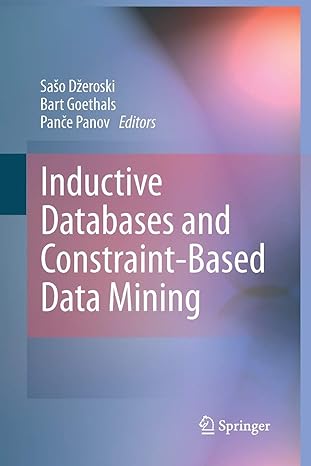Question
1) Consider the transaction database below. Suppose minsup = 40%. Transaction ID Items Bought 1 {B, D, E} 2 {B, C, D} 3 {B, D,
1) Consider the transaction database below. Suppose minsup = 40%.
| Transaction ID | Items Bought |
| 1 | {B, D, E} |
| 2 | {B, C, D} |
| 3 | {B, D, E} |
| 4 | {A, C, D, E} |
| 5 | {B, C, D, E} |
| 6 | {B, D, E} |
| 7 | {C, D} |
| 8 | {A, B, C} |
| 9 | {A, D, E} |
| 10 | {B, D} |
a. List all frequent 1-itemsets with their support measures
b. List all frequent 2-itemsets with their support measures. Generate candidates by applying the Apriori principle.
c. List all candidate 3-itemsets using the following candidate generation strategies:
1. Fk-1 x F1
2. Fk-1 x Fk-1
d. List all frequent 3-itemsets after pruning (use the candidate 3-itemsets you generated in c(2) above). Show their support measures.
e. Suppose minconf = 50%. List all association rules from the previous problem that survive the pruning. Show their confidence measures.
Step by Step Solution
There are 3 Steps involved in it
Step: 1

Get Instant Access to Expert-Tailored Solutions
See step-by-step solutions with expert insights and AI powered tools for academic success
Step: 2

Step: 3

Ace Your Homework with AI
Get the answers you need in no time with our AI-driven, step-by-step assistance
Get Started


